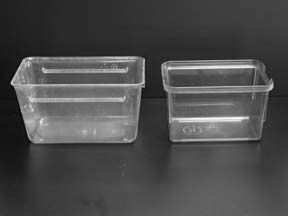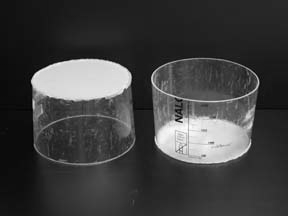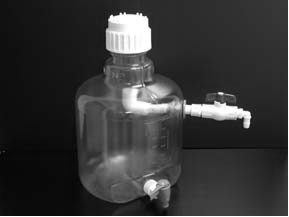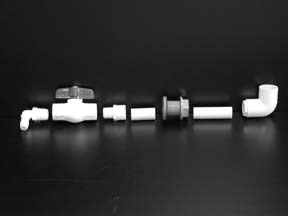Paramecium Recipes for Large and Small Facilities
(Source: C. Barton from Zebrafish Book 5th Edition)
Ingredients and other necessary items
Cultures
- Sterile Petri-dishes, at least 150 x10 mm
- Fish water or dechlorinated tap water, autoclaved
- Nutritional brewers yeast tablets, any brand
- Autoclaved whole-wheat kernels
Sub-Cultures
- Plastic containers, 500-1000 ml (Fig. 1)
- Powdered brewers yeast, any brand
- Autoclaved whole-wheat kernels
- Dechlorinated tap water or fish water, filtered
Cages
- 500-1000 ml plastic containers
- Powdered brewers yeast
- Autoclaved whole-wheat kernels
- Dechlorinated tap water or fish water, filtered
Other Necessary Items
- Measuring spoons, 0.05 and 0.1 gram sizes
- Warm room with medium light (70-80°F)
- Strainers made from 105 and 23 µm polyester filter cloth (Fig. 2)
- Paramecia collector (for description see Figs. 3-4)
List of terms
Cultures
Stage 1 of the paramecium production process. Sterile paramecium food cultures grown in at least 150x10 mm glass or plastic Petri dishes, used to make paramecia
Sub-cultures
Stage 2 of the paramecium production process. Clean, but not sterile, paramecium cultures grown in 500-1000 ml filtered fish water or dechlorinated tap water. These are used to make cages.
Cages
Stage 3 of the paramecium production process. Clean, but not sterile, paramecia grown in 500-1000 ml filtered fish water. The only difference between the cage and subculture methods is that with the cage method, the paramecium population is started with a subculture and in the subculture method, the paramecium population is started with a culture. This is done to achieve optimum population density when harvesting paramecia for use in the nursery and to produce enough culture to inoculate a large number of cages.
The containers used for cages and subcultures should hold 500-1000 ml water and be easy to wash. Ideally, they should withstand high temperatures so that they can be cleaned using a cage washer or high temperature dishwasher. The containers should also allow for a good water surface to air ratio, which is vital in growing quality paramecia.
Making paramecium cultures
Obtaining a starter culture
Starter cultures can be obtained from ZIRC or other commercial retailers such as Carolina Biological. Commercial cultures usually contain other organisms that should be removed before using them in your facility. Cultures obtained from ZIRC have already been "cleaned up", but it is still a good idea to examine each culture carefully under a microscope before using it.
Preparation
Before working with paramecia, it is a good to start with a sterilized work surface that will reduce the chance of contaminating the cultures. First, boil a small amount of autoclaved whole-wheat kernels (1tbs) in autoclaved water (autoclaved fish water or dechlorinated tap water, depending on what is available) for 10-15 minutes on a hot plate. While the kernels are boiling, set out seven large Petri dishes. Fill each dish half full of autoclaved water. To each dish, add one small piece of a brewer's yeast tablet. The pieces are approximately 0.01 grams each and are about 2x2x2 mm in size. When the wheat is done boiling, remove it from the hot plate, pour off excess liquid and add 4-5 wheat kernels to each plate. Wait a couple of minutes to allow the wheat to cool completely in the water before starting the next step.
Now you are ready to add the paramecium starter culture. The paramecium starter culture obtained from ZIRC should be divided equally among the seven plates you have prepared. If you are not using ZIRC cultures, than add approximately 15 ml of dense culture to each Petri dish. Cover each Petri dish and label it with the date. The ideal temperature for growing paramecium cultures is between 75-80°F.
Refreshing Cultures
Culture sets (each set of seven cultures made from one Petri-dish) need to be refreshed every 7 to 14 days. Generally, two sets of cultures are kept growing at all times, so use the older set to make a new set of cultures and subcultures.
Take the older set of cultures, which should be 7-14 days old, and examine each dish under a microscope for density and any possible contamination. Choose the densest culture and use this to make the new set of cultures. Pick out the 2nd and 3rd best cultures and set these aside to make subcultures. Check the remaining culture plates to make sure they are healthy and then keep them as a back up until the next week's production day.
Making subcultures
To make subcultures, set out 4 clean cages and fill each one with 500-1000 ml of sterile fish water, filtered fish water or filtered de-chlorinated tap water. For smaller facilities that do not require a large amount of water for paramecium production, autoclaving is the easiest way to get clean water for paramecium production.
For larger facilities that need more food and therefore more water, a filtration unit is probably more appropriate. At ZIRC, water used to grow paramecia is filtered through a 0.23 µm Millipore Stainless-Steel Pressure Filter.
To each cage, add 0.05 g powdered brewer's yeast tablets. Powdered brewer's yeast products are available but do not work as well as the powdered tablets. Also, add 10 dry whole-wheat kernels that have been autoclaved. Ten kernels is approximately ¼ tsp. Retrieve the 2 culture dishes that were set aside and add ½ of each culture to each cage.
Label the cage with the date, mark it as a subculture and cover the containers with a clear lid (long pieces of Plexiglas work well). Do not cover the containers with airtight lids! If container lids are tight fitting, drill some air holes in them.
The subcultures generally take 7-10 days to reach optimum density and will remain at that density for about 1-2 weeks.
Making cages
Set out as many cages as you will need for food the following week. For example, if you are making food on Monday, calculate how much food you will need for the following week based on how many fish will be in the nursery. Take into account the amount of time the paramecia need to repopulate and when they will be ready for harvest.
Fill each cage with 500-1000 ml of the same water used to make subcultures. To each cage, add 0.05g powdered brewer's yeast tablets. Also, add ¼ tsp dry whole-wheat kernels that have been autoclaved. Each cage receives 30-50 ml of subculture. Be sure to stir the subculture before adding it to the cages because the paramecia will collect in pockets in the cage. Label the cages with the date and cover.
The cages usually take approximately 7-10 days to reach optimum density and are usable for up to two weeks after. It is recommended that you test all stages of the paramecia regularly to make sure they are contaminant free and healthy.
Harvesting paramecia from cages
Calculating the Amount of Concentrated Paramecia Needed
While in the autonursery, baby zebrafish are fed 40 ml of concentrated paramecia twice per day. Calculate how much concentrated paramecia you will need for both the morning and afternoon feedings based on these numbers. The amount of paramecia that each cage will produce varies depending on several factors including container volume, environmental conditions such as temperature and light intensity, and the age of the paramecia. Each 500 ml container of paramecia should produce about 300-500 ml of concentrated paramecia.
The best way to determine how much food each cage will make in your facility is to prepare one cage to the proper density. After seeing how much food each cage makes, you can calculate the number of cages you will need based on the number of fish to feed. The proper density for concentrated paramecia, as prepared for feeding fish, should be 100 paramecia/ml liquid.
Concentrated paramecia preparation
Paramecia need to be thoroughly filtered and rinsed before they can be concentrated and fed to fish. Pour each cage through the 105 µm strainer (Fig. 2), collecting the liquid and paramecia in a container below and discarding the debris caught in the strainer. Rinsing the strainer between cages will make this process quicker and easier.
Pour the filtered paramecia into the paramecium collector (Figs. 3-4), making sure that both valves are shut, and top off with fish water. Let the collector sit for 15-20 minutes. This will allow the paramecia to gather at the top of the collector. To collect the paramecia, put a large container under the top valve. Open the valve and allow all of the paramecia at the top of the collector to drain into the container. Shut the top valve and refill the collector with fish water. Repeat this step until you have retrieved the majority of the paramecia. This usually requires 2-3 collections. After the last collection, the collector can be emptied and the remaining liquid discarded by opening the bottom valve and allowing it to drain.
The last step in the filtration process is to remove any residual ammonia in the water from the paramecia. This is achieved by pouring the previously collected paramecia into a 23 µm strainer (Fig. 2). The paramecia are too large to fit through the 23 µm material. Unlike the 105 µm strainer, the 23 µm strainer holds the paramecia in the strainer and passes the liquid. After the majority of the water is drained, rinse the paramecia with fish water to remove any remaining ammonia.
After rinsing, pour the paramecia into a clean container. Fill the container with clean fish water until a concentration of 100-150 paramecia/ml is achieved. Use this to feed. Note: Before you feed using the paramecia, check the ammonia level with a test kit. If it shows any traces of ammonia, repeat the 23 µm mesh straining process.
Modifications of paramecium recipe for small facilities
Small facilities may require a much smaller amount of food than the standard procedure yields. Several modifications to the paramecium production process can meet the needs of a smaller facility.
Removing the subculture step
One easy way to tailor the procedure to meet a smaller facility's needs, is to remove the subculture step. Instead of using culture plates to make subcultures and then using those subcultures to inoculate a large number of cages, each culture plate can be used to inoculate up to 4 cages directly. Remember to start enough Petri plate cultures each week to start new cultures the next week, to make food cages and to provide two backup plates. For example, if you are making 7 plate sets, 1 will be used for new plates, 2 should be saved for backup, leaving 4 to make cages. Four plates will make 16 cages of paramecia.
Petri dishes
Facilities needing less than 16 cages of food per week can reduce the number of Petri plates used in each batch. This decreases the amount of space needed for storing cultures, decreases the amount of supplies needed and reduces the amount of labor required to maintain the plates. Making fewer plates also decreases labor because most of the ingredients and supplies require autoclaving.
Cage size
If 1 liter cages are too large for the daily needs of the facility, smaller cages can be made, as long as the recipe is adjusting accordingly.
Figure 1. The container on the left is a polycarbonate Nalgene animal cage (24x14x13 cm). It has a volume of approximately 2 liters. The container on the right is a Thoren crossing cage and holds approximately 1 liter. Both containers work well for paramecia and any similar containers should be adequate.
Figure 2. Strainers used in the paramecium making process are hand made by cutting a large plastic beaker into cylinders. Polyester filter cloth is then fixed to one side using hot glue.
Figure 3. The paramecium collector is made from a carboy, with a spigot at the bottom, and various plumbing fixtures (Fig. 4). A 16 liter carboy is recommended for larger facilities, although an 8 liter carboy will work well for those needing to make only small amounts of paramecia.
Figure 4. The top drain is made using (from left to right) 90° tubing adapter (½" i.d., ½" threaded), ½" PVC ball valve, ½" male adapter, a 2" length of ½" PVC pipe, ½" bulk head fitting, ½" PVC pipe, ½" 90° elbow. The length of the second piece of PVC pipe is determined by what size container you are using. The elbow needs to sit directly below the center of the opening in the carboy. Cut the PVC pipe to accommodate this. It is better to press fit the pieces together as opposed to PVC gluing them. This makes dismantling easier when the unit needs cleaning.



